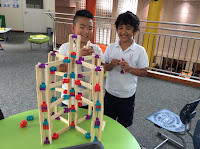Professional Development - November Task 1
In my grade 5 classroom, I've been working with Alessandro with his reading. Initially, he hasn't been reading at home or during class time. He was not interested in reading at all. Ms. Sedro introduce me to this method called Neurological Impress Reading (N.I.M.) I am to sit and read with him everyday for 15mins without fail. We do it daily for 8-10 weeks. When it works, it tends to give him a big improvement in reading fluency.
My first reading lesson with Ale was on September and we read a book by Gordon Korman, ISLAND Book 1. I have to pull him out from the group/class everyday at 2:30pm to start reading. He will give excuses by trying to complete his work first so that he could delay his reading. We read in the group room where it was quiet and have less distractions. He was not really comfortable reading with me on the first week. He doesn't want to read and when he reads, his voice was so soft and I could hardly hear him. He stops reading every time there was a sound or people coming in. I will prompt him to start reading and tell him not to stop. He gets distracted easily and fidgety most of the time. After the second week, I could see that he was willing to start and read with me voluntarily. I also noticed that he was less conscious of me sitting beside him and his body began to feel more relax, not stiff and fidgety.
By the third week, he was the one who came to me and remind me that it was time to do our reading session. I was so proud of Alessandro and told him so. We each take turns to read a page alternately. We built a good rapport with each other and I could see that Alessandro was more relax and comfortable reading by himself. After reading for 15 mins each day on the fourth week, he started to ask questions about the book we read. He was curious to know what will happen next in the story so, he was excited and look forward to our next day reading session. We laughed at some funny parts in the story and I asked him to make a prediction on what will happen next.
By the end of eight weeks in November, we almost finished Island, Book 2. Alessandro has improved on his reading skill and fluency tremendously. He was reading at a comfortable pace and understand the story line. He was confident reading on his own and to me. He can do retelling pretty well. He now reads in class and at home independently. Ms. Sedro received great feedback from his mom stating that he nows read voluntarily at home without being prompt.
Here is the link to the article about the neurological impress method of reading.
Currently, I'm working with another student, Gabriella. We just started this month in December with a book called, POPPY by AVI.
From what I noticed, this method do work. Consistency in working with students and having trust in their ability to complete the task in hand helps them to be a better students.
From what I noticed, this method do work. Consistency in working with students and having trust in their ability to complete the task in hand helps them to be a better students.





















